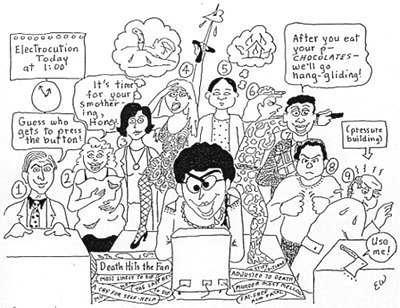Jaqueline Girdner Brings the 9 Types to Hordes of Mystery Readers
By Elizabeth Wagele
Do you ever get a little tired of discussing Enneagram theories? Sometimes I get the urge for more direct experiences of the Enneagram through art, music, cartoons, movies—and through Jaqueline Girdner's clever, colorful, and fun whodunits. With 400,000 books sold (in paperback and more recently in hard cover), I'm not her only fan!
When Girdner begins working on a new mystery, she doesn't consciously create the murderer. The murderer springs to life, the author says, straight from her intuition. Girdner has no choice but to do whatever research and filling in of details is necessary to create the finished product. Without planning it, Jaki has found murderers among all the Enneagram types except for 6 and 9 in her nine published books and her newly finished manuscript. The homicidal score so far: three 1s, two 4s, and one each of 2, 3, 5, 7, and 8. She won't tell us which books these murderous types are in, of course, because she knows we Enneagram people are smart enough to spot the type, finger the murderer, and kill the suspense for ourselves.

I asked Girdner why a 6 or 9 murderer hasn't appeared. It could still happen, she said. A good motive for a 6 might be orders from a respected superior. A 9 might be in the middle of a conflict between two friends that can only be solved one way; the 9's years of pent-up anger would help carry it through.
Though the murderers and their types sneak up on her, Girdner is able to plan the distribution of Enneagram types among the other suspects. Discovering the Enneagram system after writing her fourth book, she realized it was perfect. Perfect for murder, that is. In a traditional whodunit, one murder victim and eight suspects make good proportions for challenging the reader. Jaki realized that 8 + 1 = 9 and it was time to start typing by Enneagram.
Once Girdner gets to know her murderer and decides what type he or she is, she then creates a suspect for each of the remaining types. She says there are a number of practical reasons for doing this: it helps her figure out what her suspects might do, tease out the subtleties of character, and make the murder suspects distinct.
Haven't you read a lot of books where all the characters sound the same? Well, Girdner's don't.
Shadows Unveiled
We can't help looking at the whole of Girdner's characters, including their shadow side, to try to get inside them and figure out why each suspect would be motivated to kill. As a 5, I think of myself as gentle, honest, and one who can keep her emotions under control. When I read about another 5 committing murder, however, I'm more able to admit that I might be capable of murder, too.
One ideal of the Enneagram is to experience how it feels to be in the skin of each type. Gurdjieff and his followers had methods for doing this using movement. Girdner gets to know her nine characters inside and out through the process of writing. Once she knows their types, and a few other distinguishing features, she begins walking in their shoes. She especially savors trekking in the murderer's shoes, often for months, as she coaxes out a plot. She stares in the mirror to see what she looks like as a person considering homicide, listens to her murderous voice, and watches her murderous mannerisms. Then she kills... fictionally, of course.
Once, Girdner, a 5, was walking in a murderous 8's shoes and a solicitor showed up at her front door. (As a fellow 5, I can tell you there's nothing more satisfying than successfully impersonating an 8!) The poor solicitor felt lucky to get away alive, but only after promises of murderous intent. Feeling confident, Girdner went back to her word processor and wrote the scene into her manuscript, gloating that, for once, she had acted effectively.
Another ideal of the Enneagram is to develop compassion for one's own and the other 8 types. 5s can find other people invasive, irritatingly loud, or (let's be honest) stupid. But Girdner has learned to be more objective about people's foibles. She says she never meets jerks anymore... she meets material. Her chapter in the Portable Writers' Conference (a guide book to getting and staying published, edited by Stephen Blake Mettee), called "Meet a Jerk, Get to Work," tells writers how to find fiction characters and settings in daily life: by observation, of course.
Why?
Why is a 5 writing whodunits? Could it be something about getting to control a small universe? Also, in the end of a good whodunit, Girdner insists, a solution is reached by superior intelligence, all loose ends are tied up, and sanity reigns: a 5's paradise. There's also the curiosity angle, and the chance to use arcane knowledge and brilliant observation, or in her protagonist's case, belated brilliant observation. Girdner's protagonist is Kate Jasper, another 5, who is a karmically impaired vegetarian (she has a propensity for tripping over dead bodies), does t'ai chi, and owns a gag-gift business in self-help-saturated Marin County near San Francisco. Girdner believes that many of her fellow mystery authors are also 5s. There are also quite a few 4s, and some 1s and 6s. She believes that 5s tend to write the more intellectual whodunits, where 4s write more grievance-driven hard-boiled mysteries. But then, she's a 5.
In Girdner's latest book, Death Hits the Fan (page 11-12), three authors attend the same book signing:
"All three authors came trooping down the main aisle in front of Ivan. The first one to emerge was male, with a long, morose face and even longer dark hair tied back in a ponytail. I was pretty sure he wasn't the owner of the voice. Unless he had delusions of daintiness. He had to be Ted Brown (a 4)... The next one was tall and elegant, a swan inflowing blue silk that suited her sleek, well-groomed persona. I would have bet she was S.X. Greenfree (a 3). Because the last in line had to be Yvette Cassell, the creator of the leprechaun sleuth. She was under five feet, no bigger than a leprechaun herself, with a narrow face, sharp nose, and close-set eyes under tinted glasses, her hair drawn back in a ponytail, not unlike Ted Brown's, with short uneven curls in the front." (This one is a 5; in fact she is Girdner's own parody of herself.)
The authors and the fans (1, 2, 6, 7, and 8) collide in an explosion of Enneagram types that leaves one author dead and the bookstore owner (a 9) very apologetic.
In her next book, Murder on the Astral Plane, our 5 amateur sleuth, Kate Jasper, is tortured by a bumbling, Enneagram book-toting policeman who tries to figure out who did the murder based on the suspects' Enneagram types.
I asked Girdner why so many of her murderers are 1s. The answer: "Self-righteous anger and a firm belief that revenge done for the right cause against a person the 1 considers evil beyond redemption is okay." Girdner says she didn't plan so many 1s as killers, but they just seem to enter her brain on little homicidal feet.
Which just goes to prove the complexity of the Enneagram system. No type is immune from the lure of murder. Not even yours!
Oh, yes! And one additional fun reason to write mysteries is thal Girdner's characters can say things she never would... aloud.
Elizabeth Wagele is the author of The Enneagram of Parenting; Are You My Type, Am I Yours?; and The Enneagram Made Easy. She is also the author and performer of the Beethoven Enneagram CD. This article originally appeared in the Enneagram Monthly, May 1998.
Article and cartoon © 1999 by Elizabeth Wagele.
























